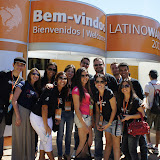FOSS4G in Photos and Stories
There was an army of photographers and video coverage at the event, so I only went around with my camera a couple of times. That said there were some wonderful moments to capture and share.Flicker:
All the wonderful people!
Social and Sol Katz Award
Speaking of beautiful and inspirational people - Astrid Emde was recognized by her peers with a Sol Katz award (which is one of the highest honours our community can extend.)
The social was out over looking the ocean allowing everyone to enjoy the sunset, the ocean waves and a whole lot of dancing.

OSGeo Booth
The OSGeo booth which was setup as a hangout area with sofas and tables and a bit of calm in a busy conference. Jeff McKenna was ever present greeting people, welcoming them to OSGeo, and setting up local chapters.

Conference Committee
The conference committee was as you would expect almost impossible to photograph in the same place. Thank you to everyone who helped make this event near and far.
FOSS4G Telegram Channel
There were several lines of communication during the event, twitter as we have come to expect, and also a telegram channel. This was simply amazing to take part in and it is still ongoing!In the lead up to the conference you could tune in and hear about the progress of the overland bus gathering attendees to the event, during the event the social activities provided updates (and directions), and after the conference the channel is still active with people making connections and plans to attend next year.


FOSS4G Presentations and Outreach
This was a busy conference for me personally. Sometime during the Bonn code sprint I decided I really wanted to go and submitted a bunch of talks.
Open Source Geospatial Foundation
The AGM took place on Thursday morning, bright and early, and once again shows all the amazing our community can do. This is one of your best chances to learn what the local chapters are doing around the world.It can be a little intimidating to know where to start with OSGeo, each group has a different way they like to communicate. This presentation is not nearly as much fun as the AGM but does introduce you to who is where and how you can take part.
Open Source Developer Outreach
There is a lot of help available to open source projects; this presentation turned into good chat about how LocationTech and OSGeo (and Apache and Free Software Foundation) are available to help.
Projects and Technology
GeoServer Ecosystem was a chance to look at what the project is actually used for, rather than just the new features added this year. Andrea provided a series of impressive case studies showing how organizations "succeed with geoserver". I was able to follow this up showing how geoserver is used in as a component in products like Boundless Server, GeoNetwork and GeoNode.
Rob had a bit of trouble finding me (sorry Rob) for our State of JTS presentation. Rob had a look at how JTS is evolving under pressure from the cloud projects at LocationTech, and we explored the recent addition of XYZM support and plans for the future.




















